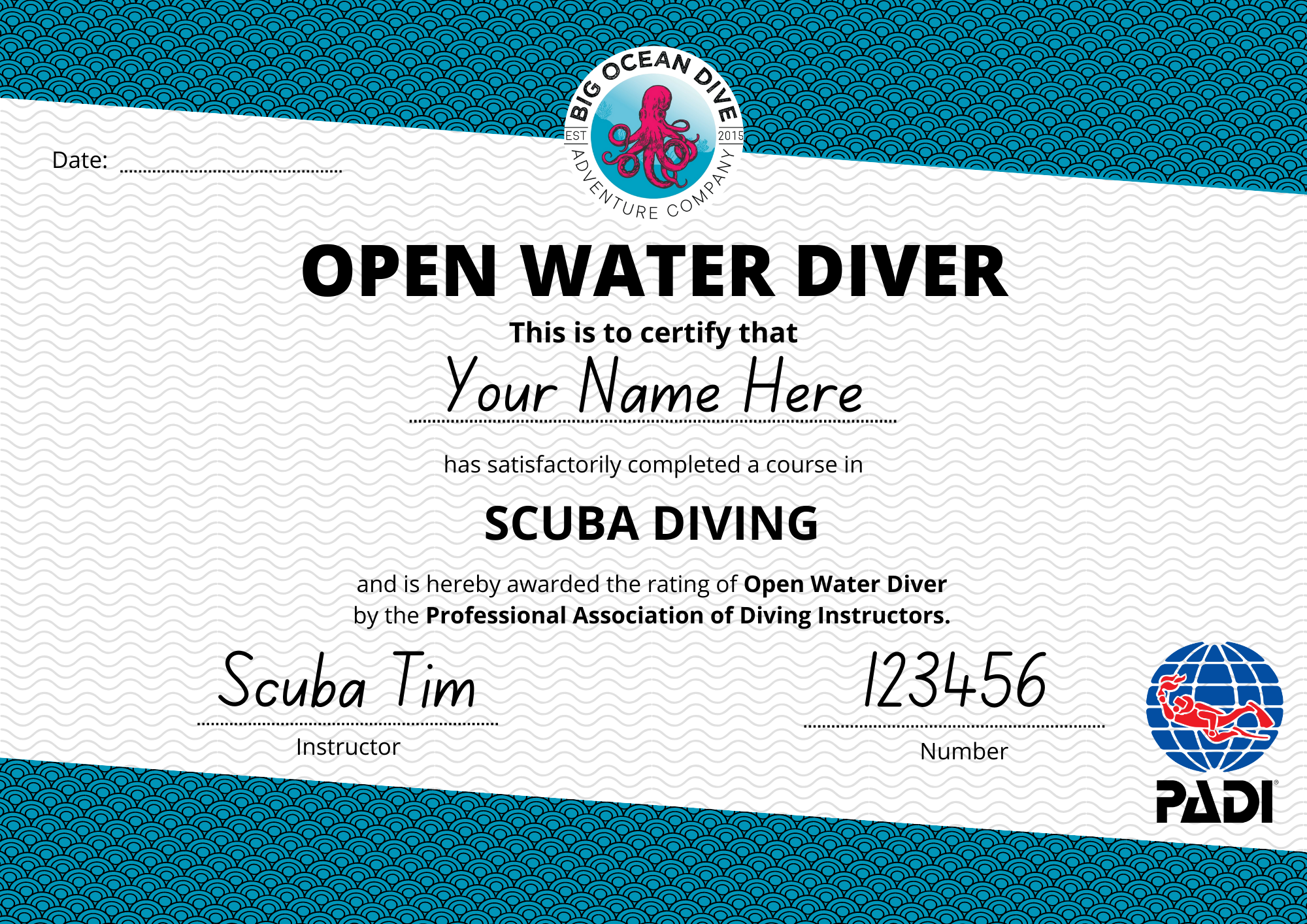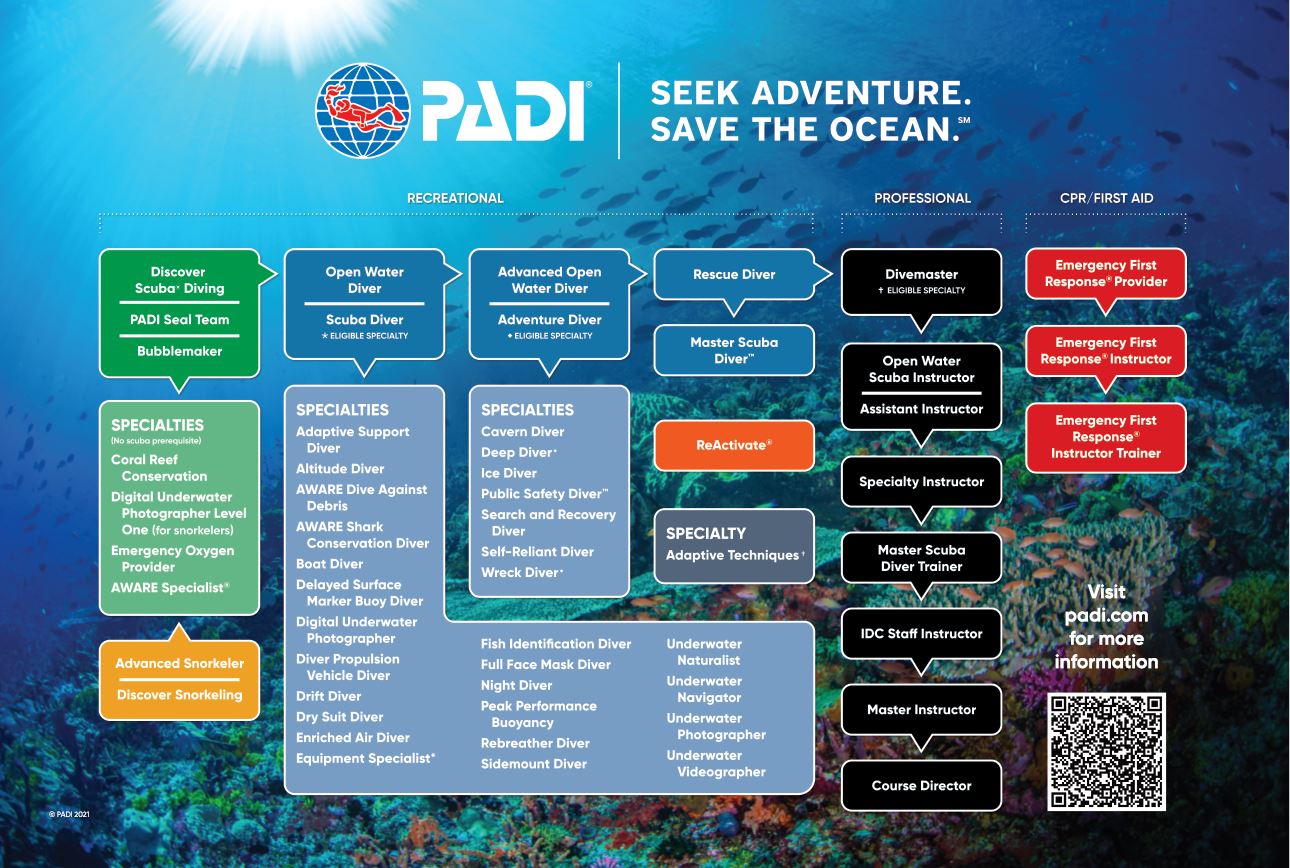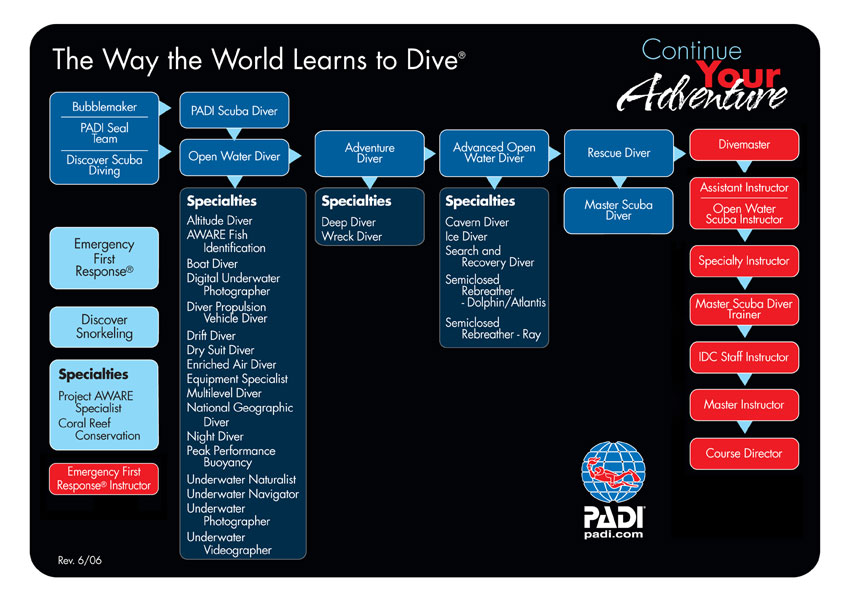PADI Open Water Diver: Depth Limits, Certification & More!
Ever wondered how deep the ocean's embrace extends to certified scuba divers? The gateway to underwater exploration, the PADI Open Water Diver certification, sets a definitive limit: 18 meters, or 60 feet. This benchmark depth is crucial, shaping the initial diving experiences for countless enthusiasts eager to discover the submerged wonders of our planet.
This depth isn't arbitrary; it's meticulously chosen to balance accessibility with safety. The PADI Open Water course equips divers with the fundamental skills and knowledge to navigate the underwater realm responsibly. This includes understanding buoyancy control, mastering equipment usage, and recognizing potential hazards. Limiting the initial depth allows divers to consolidate these skills in a relatively forgiving environment before venturing into more challenging scenarios. The certification, recognized globally, from the crystal-clear waters of the Caribbean to the vibrant reefs of Southeast Asia, serves as the foundational passport for aspiring scuba divers worldwide, ensuring a standardized level of competence and awareness.
| Category | Details |
|---|---|
| Certification | PADI (Professional Association of Diving Instructors) Open Water Diver |
| Depth Limit | 18 meters (60 feet) |
| Skills Covered | Buoyancy control, equipment usage, underwater communication, safety procedures, problem-solving. |
| Prerequisites | Minimum age (typically 10 years old), adequate swimming skills, medical clearance. |
| Course Structure | Knowledge development (theory), confined water dives (pool sessions), open water dives (ocean/lake). |
| Global Recognition | Internationally recognized certification allowing diving worldwide within the specified limits. |
| Progression | Serves as a prerequisite for advanced diving certifications like PADI Advanced Open Water Diver. |
| Related Information | PADI Open Water Diver Course Details |
However, the allure of the deep often calls, prompting many divers to seek further training. This is where the PADI Advanced Open Water Diver certification (AOWD) comes into play. Completing the AOWD course extends your depth limit to 30 meters (100 feet), opening up a new spectrum of dive sites and experiences. The AOWD course isn’t just about going deeper; it's about enhancing your skills and broadening your diving knowledge. The curriculum typically involves five adventure dives, each focused on a specific area of diving, such as deep diving, underwater navigation, and peak performance buoyancy. These dives provide practical experience under the guidance of an instructor, allowing you to hone your abilities and build confidence in a variety of underwater environments.
- Kim Sears Net Worth The Untold Story Behind Her Wealth
- Ishy Khan Wife The Untold Story Of Love Fame And Everything Inbetween
The deep dive itself, a core component of the AOWD course, is a carefully structured experience. Under the watchful eye of an instructor, you'll descend below the 18-meter limit, gaining firsthand experience with the physiological effects of depth, such as nitrogen narcosis. You'll also learn how to manage your air consumption more effectively and plan dives that take into account the increased risks associated with deeper diving. This controlled introduction to deeper environments is essential for developing the judgment and skills necessary to dive safely beyond the limits of the Open Water certification. The other adventure dives offer opportunities to explore different aspects of diving, such as underwater photography, wreck diving, or night diving, further enriching your overall diving experience.
It's important to remember that diving deeper isn't simply about bragging rights; it's about expanding your capabilities and accessing a wider range of dive sites. Some of the world's most spectacular underwater locations are only accessible to divers with advanced certifications. Take, for example, the Great Blue Hole in Belize, a mesmerizing sinkhole that plunges to depths exceeding 120 meters. While the deepest sections are beyond the reach of recreational divers, the upper portions, teeming with marine life and geological formations, are best explored by those with AOWD certification or higher. Similarly, the cenotes of the Yucatan Peninsula in Mexico, with their intricate cave systems and otherworldly beauty, often require advanced diving skills to fully appreciate.
Even within the recreational depth limits, specialized training can enhance your diving experience. PADI offers a variety of specialty courses that focus on specific areas of interest, such as underwater navigation, wreck diving, or deep diving. These courses provide in-depth knowledge and practical skills, allowing you to become a more competent and confident diver. For example, the PADI Deep Diver specialty course provides additional training in planning and executing deeper dives within recreational limits, covering topics such as gas management, decompression theory, and emergency procedures. The PADI Wreck Diver specialty course teaches you how to safely explore sunken ships and other underwater structures, while the PADI Underwater Navigation specialty course hones your skills in using a compass and natural navigation techniques to find your way underwater.
- Unveiling The World Of Gossip Websites Uk Your Ultimate Guide To The Hottest Celeb Scoops
- Mirror Daily Football Your Ultimate Guide To The Latest Football News
The decision to pursue advanced diving certifications and specialty courses should be based on your individual interests and goals. If you're passionate about underwater photography, the PADI Underwater Photographer specialty course can help you capture stunning images of the marine world. If you're fascinated by marine life, the PADI Underwater Naturalist specialty course can teach you how to identify and understand the behavior of different species. And if you're interested in exploring deeper wrecks or caves, the appropriate specialty courses are essential for ensuring your safety and enjoyment.
For younger divers, the PADI Junior Open Water Diver certification offers a pathway to explore the underwater world under specific conditions. Junior Open Water Divers aged 10-11 years old are certified to a maximum depth of 12 meters (40 feet) and must dive with a PADI Professional or certified parent or guardian. Junior Open Water Divers aged 12-14 years old are certified to the same depth as adult Open Water Divers (18 meters/60 feet) but must dive with a certified adult. These restrictions are in place to ensure the safety and well-being of young divers, who may not have the same level of experience and judgment as adults.
Regardless of your age or experience level, the PADI Open Water Diver certification is the first step on a journey of underwater exploration. It provides you with the fundamental skills and knowledge to dive safely and responsibly, opening up a world of breathtaking beauty and adventure. As you gain experience and confidence, you can choose to pursue advanced certifications and specialty courses to further enhance your skills and explore new diving opportunities. The underwater world is vast and diverse, offering endless possibilities for discovery and adventure. With the right training and equipment, you can explore its depths and experience its wonders firsthand.
The PADI system also recognizes that not everyone has the time or resources to complete the full Open Water Diver course. For those who are short on time but eager to experience the thrill of scuba diving, the PADI Scuba Diver certification offers a condensed version of the Open Water course. The PADI Scuba Diver course covers the essential skills and knowledge needed to dive safely under the direct supervision of a PADI Professional to a maximum depth of 12 meters (40 feet). While the Scuba Diver certification doesn't allow you to dive independently, it provides a great introduction to scuba diving and can be upgraded to the Open Water Diver certification with additional training.
Ultimately, the depth you can scuba dive is determined by your certification level, experience, and the specific conditions of the dive site. Always dive within your limits, follow safe diving practices, and respect the underwater environment. With proper training and preparation, you can explore the depths of the ocean safely and responsibly, and experience the wonders that lie beneath the surface. The key is to prioritize safety, continuously improve your skills, and always be mindful of the impact your diving has on the marine ecosystem.
Remember that responsible diving extends beyond your personal safety. It also encompasses protecting the fragile underwater environment. Avoid touching or disturbing marine life, be mindful of your buoyancy to prevent damage to coral reefs, and properly dispose of any trash or debris you encounter. By practicing responsible diving, you can help preserve the beauty and health of the ocean for future generations to enjoy.
The PADI Open Water Diver course typically involves a combination of classroom instruction, confined water dives (pool sessions), and open water dives. During the classroom sessions, you'll learn about diving physics, physiology, equipment, and safety procedures. In the pool sessions, you'll practice basic diving skills, such as buoyancy control, mask clearing, and regulator recovery. Finally, during the open water dives, you'll apply your skills in a real-world environment, exploring reefs, wrecks, and other underwater attractions.
Before embarking on your PADI Open Water Diver course, it's important to ensure that you meet the prerequisites. These typically include a minimum age requirement (usually 10 years old), adequate swimming skills, and medical clearance. You'll also need to be comfortable in the water and have a reasonable level of physical fitness. If you have any pre-existing medical conditions, it's essential to consult with your doctor before starting the course.
Choosing a reputable PADI dive center is crucial for ensuring a safe and enjoyable learning experience. Look for dive centers that have experienced and qualified instructors, well-maintained equipment, and a commitment to safety. Read online reviews and ask for recommendations from other divers to find a dive center that meets your needs and expectations.
Once you're certified as a PADI Open Water Diver, you'll need to continue practicing your skills and gaining experience to maintain your proficiency. Dive regularly, take refresher courses if needed, and consider joining a local dive club to connect with other divers and learn about new dive sites and techniques. The more you dive, the more comfortable and confident you'll become, and the more you'll be able to appreciate the wonders of the underwater world.
And as you progress on your diving journey, remember to always prioritize safety, respect the environment, and continue learning and improving your skills. The ocean is a vast and awe-inspiring place, and with the right training and attitude, you can explore its depths and discover its secrets safely and responsibly.
The depth limits associated with different PADI certifications are not arbitrary; they are based on a combination of factors, including the skills and knowledge acquired during the training, the potential risks associated with deeper diving, and the recommendations of experienced diving professionals. These limits are designed to ensure the safety and well-being of divers, while still allowing them to explore a wide range of underwater environments.
As you gain experience and progress through the PADI system, you'll learn more about the physiological effects of depth, such as nitrogen narcosis and decompression sickness. You'll also learn how to plan dives that take these factors into account, and how to manage your air consumption more effectively. This knowledge is essential for diving safely beyond the limits of the Open Water certification.
The PADI Advanced Open Water Diver course provides a structured and supervised environment for learning these advanced skills. The course includes five adventure dives, each focused on a specific area of diving, such as deep diving, underwater navigation, and peak performance buoyancy. These dives provide practical experience under the guidance of an instructor, allowing you to hone your abilities and build confidence in a variety of underwater environments.
The deep dive, a core component of the AOWD course, is a carefully structured experience. Under the watchful eye of an instructor, you'll descend below the 18-meter limit, gaining firsthand experience with the physiological effects of depth, such as nitrogen narcosis. You'll also learn how to manage your air consumption more effectively and plan dives that take into account the increased risks associated with deeper diving. This controlled introduction to deeper environments is essential for developing the judgment and skills necessary to dive safely beyond the limits of the Open Water certification.
In addition to the deep dive, the AOWD course also includes an underwater navigation dive, which teaches you how to use a compass and natural navigation techniques to find your way underwater. This skill is essential for exploring larger dive sites and for avoiding getting lost or separated from your buddy. The other adventure dives offer opportunities to explore different aspects of diving, such as underwater photography, wreck diving, or night diving, further enriching your overall diving experience.
Beyond the AOWD course, PADI offers a variety of specialty courses that focus on specific areas of interest, such as underwater navigation, wreck diving, or deep diving. These courses provide in-depth knowledge and practical skills, allowing you to become a more competent and confident diver. For example, the PADI Deep Diver specialty course provides additional training in planning and executing deeper dives within recreational limits, covering topics such as gas management, decompression theory, and emergency procedures.
The PADI Wreck Diver specialty course teaches you how to safely explore sunken ships and other underwater structures, while the PADI Underwater Navigation specialty course hones your skills in using a compass and natural navigation techniques to find your way underwater. These specialty courses can significantly enhance your diving experience and allow you to explore a wider range of underwater environments.
Before diving at any new location, it's essential to research the local conditions, including the water temperature, visibility, currents, and potential hazards. Talk to local dive operators and experienced divers to get their insights and recommendations. Always dive within your limits and be prepared for unexpected situations. The ocean is a dynamic and unpredictable environment, and it's important to be prepared for anything that might arise.
In addition to your diving certifications and training, it's also important to have the right equipment. This includes a properly fitting wetsuit or drysuit, a comfortable mask and fins, a reliable regulator and BCD, and a dive computer that tracks your depth, time, and air consumption. Make sure your equipment is well-maintained and serviced regularly to ensure its proper functioning.
Finally, remember that diving is a team sport. Always dive with a buddy and communicate effectively throughout the dive. Plan your dive together, agree on a maximum depth and time, and establish hand signals for communicating underwater. Stay within sight of your buddy and be prepared to assist them if they encounter any problems. By working together as a team, you can enhance your safety and enjoyment and create unforgettable diving experiences.



Detail Author:
- Name : Joanny McKenzie DDS
- Username : destin.larson
- Email : jacey07@yahoo.com
- Birthdate : 1991-02-03
- Address : 46325 Ron Walk Elsieport, MN 99973-8030
- Phone : +1 (440) 720-1727
- Company : Wintheiser, Schneider and Funk
- Job : Insulation Worker
- Bio : Quia ad consequatur voluptates voluptate repudiandae fugit. Magnam aliquid fugiat id optio porro.
Socials
twitter:
- url : https://twitter.com/eldon.johns
- username : eldon.johns
- bio : Et voluptas consectetur deserunt eius animi voluptatem sit. Quo ullam et molestiae molestias fugit. Quam aliquid rerum et sed omnis sint tempore.
- followers : 5232
- following : 1822
facebook:
- url : https://facebook.com/eldon_id
- username : eldon_id
- bio : Quibusdam ab voluptatum qui sed inventore ut in sed.
- followers : 1924
- following : 1798
instagram:
- url : https://instagram.com/eldon_id
- username : eldon_id
- bio : Quidem earum reiciendis et dicta. At itaque porro velit facere. Optio eos ea quia tempora non eum.
- followers : 651
- following : 348
tiktok:
- url : https://tiktok.com/@eldon_official
- username : eldon_official
- bio : Modi labore neque quaerat non aut dolores laudantium.
- followers : 6367
- following : 208
linkedin:
- url : https://linkedin.com/in/eldonjohns
- username : eldonjohns
- bio : Voluptas modi laudantium totam repellendus.
- followers : 1763
- following : 1225